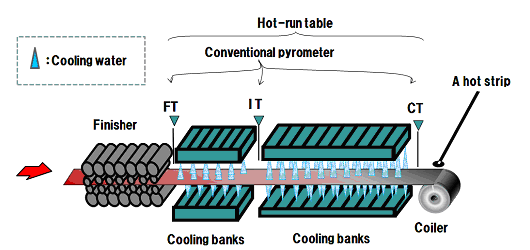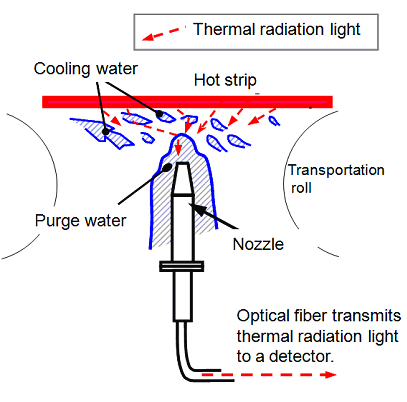Sumitomo Metals Develops New Temperature Measurement and Control Technologies for Manufacturing of High-tensile Strength Hot Strip
-Major Advance Both in Quality and Efficiency for Production of Steel Sheet for Automobiles-
2009.10.13
- Sumitomo Metal Industries, Ltd.
Sumitomo Metal Industries, Ltd. (Sumitomo Metals) has developed and put into commercial application temperature measuring technology for the cooling banks of the hot strip process(*1) as well as high precision control technology based on the use of the former technology. This has enabled the Company to manufacture better quality high-tensile strength hot strip(*2) in a more stable manner.
The quality and properties of high-tensile strength hot strips depend on temperature control during the cooling stage right after being rolled out. To ensure better control, the temperature needs to be measured more accurately. There will be a massive amount of cooling water around the hot strip during its cooling process and, with the conventional temperature measurement method, such cooling water made it very difficult to measure the temperature in a high accuracy. Sumitomo Metals subsequently came up with an innovative idea and developed a new technology to measure the temperature more accurately and improve temperature control precision drastically when cooling strip. As a result, high tensile hot strip detect length beyond a tolerable margin of error in the measuring temperature before the coiler were almost halved, enabling manufacturing of high-tensile strength hot strip with more stable quality.
In recent years, demand for high-tensile strength steel has been rising as more lightweight vehicles have become desirable in an effort to reduce CO2 emissions. Sumitomo Metals completed development of the technologies mentioned above in 2007 and put them into commercial application in 2008. Such technologies are innovative and needed to advance both in quality and efficiency for us, a large-scale manufacturer of steel sheet for automobiles. Our Kashima Steel Works has a hot strip mill with an annual capacity of 5 million tons, one of the world largest of its kind, and 60% of its products are steel sheet for automobiles.
1. Problems in measuring temperature of hot strip before coiler
Conventionally, the temperature of a hot strip on a hot-run table was measured at three points as shown in graph 1. At these three points of just after being rolled out (referred to as FT in Graph 1), in-between two cooling banks (IT in Graph 1), and before the coiler (post-cooling temperature; CT in Graph 1), the temperature was measured by pyrometers(*3) and then controlled based on the results.

Graph 1: Conventional temperature measurement method on a hot-run table
Using the temperatures at the FT point and the IT point as well as the heat transfer model, the temperature of steel sheet up to the end of the cooling stage is estimated, and then a pattern to open or close nozzles of cooling water is set so as to match the actual temperature to a targeted temperature. This means that precision in controlling the temperature before the coiler depends on how precisely the temperature of the steel plate is estimated.
In general, when the surface temperature of a hot strip declines relatively low due to cooling water, slight changes on the surface, steel components, or various other small factors may affect the heat transition between the hot strip surface and water, and a sudden rapid cool-down of the hot strip surface, called transition boiling(*4), may occur. This makes temperature control extremely difficult. Another problem is that the temperature before the coiler may cause significant changes in the material properties of high-tensile strength hot strip. Thus, the margin of error for such type of hot strip is set at a smaller level than for general steel. Consequently, more precision is required in controlling the temperature before the coiler. Moreover, the high-tensile strength hot strip is coiled at a relatively low temperature so that it can gain its properties. With the conventional method, the level of precision in controlling the temperature has been a problem to make the temperature before the coiler beyond a tolerable margin of error and result in the production of defects.
2. Problems with conventional temperature measurement methods
Conventionally, pyrometers are used to measure temperature in a hot-run table of a hot strip production line. However, it was difficult or impossible to measure the hot strip temperature in the cooling banks because there was too much cooling water and thermal radiation light to be used for measurement damps the water. Subsequently, pyrometers were installed outside of the cooling banks, and the top surface temperature of the hot strip was measured by scattering away water drops with the use of an air purge. In this way, problems involving a large margin of error or the inability to measure were somewhat resolved. This time, Sumitomo Metals developed a unique measurement method which enables highly accurate measurement of hot strip temperature in cooling banks.
3. Development of Fountain pyrometer, a new temperature measurement method
Sumitomo Metals has developed a measurement method which is not affected by cooling water. The company used an idea that is a "reversal" of the conventional one. Instead of scattering water by air purge, water purge was used like the water flow from a fountain and stable temperature measurement thus became possible.

Graph 2: Fountain pyrometer
(1) Absorption of thermal radiation light by water and countermeasure
In general, thermal radiation light detected by a pyrometer is absorbed strongly by water. The degree of such absorption or lack
of transparency depends on the wavelength of the light. The fountain pyrometers we have developed can reduce absorption
errors by avoiding the lights in the wavelengths of high absorption and detecting only the thermal radiation light, which is high in
spectral transmittance.
(2) Attenuation of thermal radiation light caused by scattering effect of water drops and countermeasure
Based on an idea to measure the temperature by utilizing only thermal radiation light which is hard for water to absorb and thus
highly transparent, Sumitomo Metals has developed a method to use a water purge like a fountain on the path between a
measurement sensor head and steel plate and create a light path where heat radiation can be transmitted stably. This enables
a reduction in scattering of thermal radiation light caused by water drops and achieves stable measurement of temperature.
This new type of temperature measurement equipment is called a "Fountain pyrometer."
4. New control method based on use of measured temperature in cooling banks
In addition to the above-mentioned unique pyrometer, Sumitomo Metals has developed a new control technology related to the temperature of hot strip. The control functions include "Feed forward," which estimates the subsequent temperature based on the output from the new pyrometer. A hot strip runs through a run-out table at a very high speed (in less than 10 seconds.) This means that when rapid cool-down at some spots was identified, only 3-5 seconds were left to change the cooling conditions for the remaining portion of the hot strip running through the table. The newly-developed "Feed forward" controls the temperature by recalculating and readjusting an optimal open/close pattern of a cooling water nozzle for the remaining path for a brief period so that the temperature before the coiler stays within a tolerable margin of error to the target temperature. By consecutively performing this to the whole surface of a hot strip, the overall temperature before the coiler can be maintained within a certain range. A prerequisite to this achievement was accurate temperature measurement of a hot strip in a cooling bank based on the use of the Fountain pyrometer.
5. Effects
By installing several Fountain pyrometers in a cooling bank and applying the new automatic control technology related to temperature before the coiler, high-precision stable control of the temperature has been realized and this has helped stabilize the quality of high-tensile strength hot strip. Specifically, the control error regarding the temperature before the coiler for high-tensile strength hot strip (590 MPa) was halved. In addition, the new technologies are contributing to other areas, such as in their application to other materials and in temperature monitoring in new material development.
In addition to the technologies mentioned above, Sumitomo Metals has made considerable achievements with its research and development activities that combine process measurement technologies and process control technologies. The former includes "development of walking control technology in hot strip rolling", which received the third Monodzukuri Nippon Grand Award in 2009.
<Terms>
*1 Hot strip manufacturing process
At a hot-rolling plant, large pieces of slabs are re-heated and deformed between rollers to form steel sheet of a few millimeters in thickness. After being rolled, steel sheet runs on a hot-run table at a speed of 10 to 25 meters per second and is cooled down by water. There are many cooling water nozzles in the cooling banks of the hot-run table. The sheet is then wound by a coiler to a hot strip coil.
*2 High-tensile strength hot strip and its manufacturing process
Hot strip is one of the major products of Sumitomo Metals' Steel Sheet, Plate & Structural Steel Company. Among various types of hot strip, high-tensile strength hot strip, being thinner but higher in strength, contributes to weight reduction and improvement in the fuel efficiency of vehicles. Another kind of high-tensile strength hot strip is not only strong, but also easy to fabricate.
*3 Pyrometer
A pyrometer is a non-contacting device that measures thermal radiation light. It can be used to determine the temperature of an object's surface, based on the principle that the stronger thermal radiation light from the surface of an object is, the higher its temperature is. This is a similar principle employed in thermography, which was used at airports as a means of detecting swine flu and preventing it from entering the country. A pyrometer is suited especially to the measurement of high-speed moving hot strip.
*4 Transition boiling
Boiling occurs in three characteristic stages, which are film, nucleate and transition boiling. Film boiling occurs between a frying-pan (or steel sheet) and water drops on its surface. A thin layer of vapor, which has low thermal conductivity, insulates the surface. The frying-pan or steel sheet is cooled down slowly because heat is relatively hard to transfer. Nucleate boiling occurs when water is boiled in a pot. Water directly touches the surface of the steel sheet, enabling a massive amount of heat transfer and a rapid cool-down of the steel sheet. Transition boiling is positioned between film boiling and nucleate boiling. After transition boiling occurs, the cooling speed accelerates. The speed of this accelerated cooling is unstable and it is hard to estimate the temperature based on the heat transfer model.
